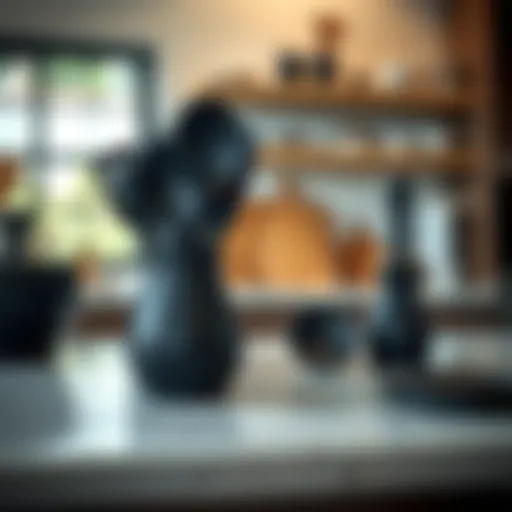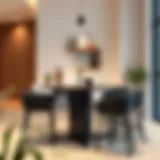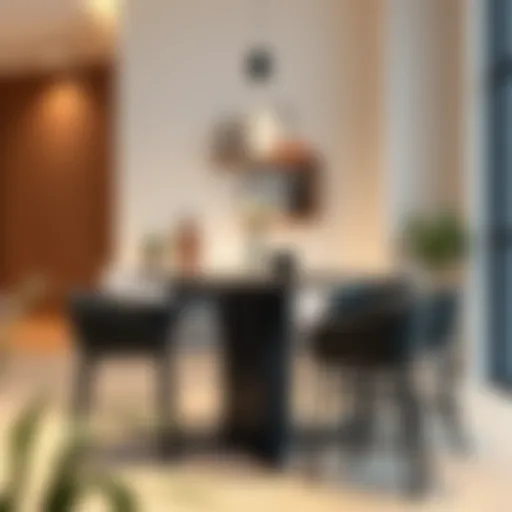Mastering the Art of Hanging a Window Scarf
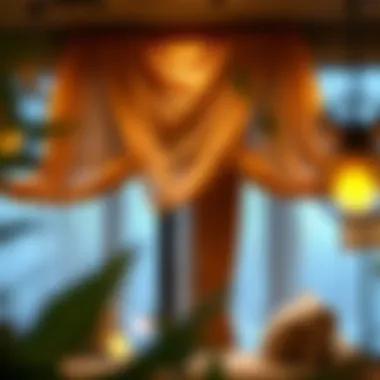
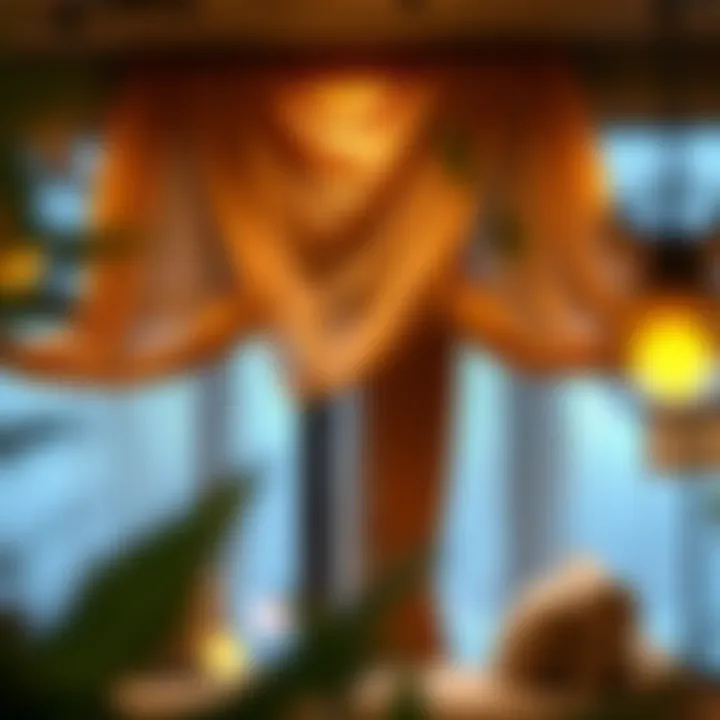
Intro
Hanging a window scarf isn't just about draping some fabric over your curtains. It’s an art form that can transform the entire atmosphere of a space. Whether you want to sprinkle a touch of elegance over a living room window or create a cozy retreat in your bedroom, mastering the technique of hanging a window scarf can be a game-changer. This guide aims to shed light on the different methods and styles, tailored to suit a variety of decors and functionality.
By understanding the basic principles behind fabric selection, installation techniques, and maintenance tips, you can ensure that your window scarf remains a statement piece, enhancing your home’s overall aesthetic. Let’s dive into the intricate world of textiles and window treatments to discover how the right scarf can elevate your decor to new heights.
Furniture Trends and Styles
When it comes to window treatments, the style of furniture in the room often complements and enhances the overall look. Here’s how current trends in furniture can inform your choice of window scarf.
Current Trends in Furniture Design
Today’s furniture trends lean towards functionality paired with aesthetics. Minimalism remains a strong influence, with clean lines and a focus on usable space. However, blending vintage pieces with contemporary decor is also gaining traction. This eclectic approach leaves room for creativity in accessories like window scarves, which can be used to bridge the gap between modern furniture and traditional charm.
- Sustainable Materials: Many homeowners are opting for eco-friendly furniture, which coincides with using natural fabrics for window scarves, such as linen or cotton.
- Bold Colors and Patterns: Furniture in bold hues makes a statement, and this trend naturally extends to window scarves. Experimenting with vibrant patterns can enliven neutral spaces.
- Multifunctional Pieces: As spaces become more compact, furniture that serves multiple purposes is in demand. This trend encourages the use of versatile, lighter window scarves that can be easily adjusted or removed as needed.
Popular Furniture Styles and Their Characteristics
Different furniture styles can dictate the type of window scarf that will work best. Here are some popular styles along with their characteristics:
- Scandinavian: Light woods, minimal decoration, and neutral colors dominate this style. A soft, sheer window scarf in white or pale tones can complement the simplicity of Scandinavian design.
- Industrial: Raw materials like steel and exposed bricks define this style. A heavier scarf with a rustic texture, perhaps in darker shades, works well to soften the starkness yet maintain an urban vibe.
- Bohemian: Rich colors and layered textiles are hallmarks of boho decor. Boldly patterned scarves can enhance the overall eclectic look, making a window a focal point rather than an afterthought.
- Traditional: Classic upholstered furniture calls for elegant draping. Luxurious materials, like silk or velvet in rich tones, elevate the sophistication of a room.
Buying and Maintenance Guides
Selecting and maintaining your window scarf can be a daunting task. Here’s a concise guide to help you navigate these choices.
Essential Tips for Purchasing Window Scarfs
- Consider Fabric Weight: Lightweight fabrics like chiffon billow beautifully, while heavier materials add depth and sophistication. Select based on the effect you wish to achieve.
- Measure Accurately: Always take precise measurements of your window length and width to ensure a perfect drape.
- Match Colors and Patterns: Ensure the scarf complements both the furniture style and color scheme of your room to create harmony.
Maintenance and Care for Different Fabrics
- Silk: Requires dry cleaning to maintain its luster. Avoid exposure to sunlight to prevent fading.
- Cotton: Machine washable, but avoid bleach to preserve colors. Iron if wrinkles appear after washing.
- Linen: Naturally wrinkled; may not need ironing if you prefer the casual look.
"The details are not the details. They make the design." - Charles Eames
For more tips on interior design and home decor, check out resources like Wikipedia, Britannica, and behavioral insights on Reddit.
Close your curtains, open your minds, and let’s create a cozy sanctuary.
Understanding Window Scarves
Window scarves bring a fresh twist to the traditional framing of window treatments. They're not just pretty pieces of fabric; they play a crucial role in shaping the mood and feel of a space. Understanding window scarves means diving into how they can affect light, texture, and even the overall aesthetics of a room. This decorative element can soften sharp lines, add warmth, or even introduce a splash of color to an otherwise bland space.
Definition and Purpose
A window scarf is typically a long length of fabric draped over a window treatment, enhancing visual interest. Instead of merely serving a functional purpose, like blocking light or providing privacy, window scarves allow for artistic expression in interior design. They can easily elevate the look of your windows without requiring a major renovation. Whether you lean towards a casual, bohemian style or a more polished, formal approach, a scarf can adapt to a wide variety of home aesthetics.
Types of Window Scarves
When it comes to selecting the right window scarf, understanding the types available is essential. Each style has its charm, making it easier to find one that resonates with your home's spirit.
Classic Panel Scarves
Classic panel scarves are perhaps the most recognized form of window scarf. These fabrics typically fall straight and utilize an elegant drape, showcasing their luxurious texture and color. A key characteristic of classic panel scarves is their refined look, making them a favorite in formal settings like dining rooms or entryways. They bring a touch of sophistication while being relatively simple to style.
One unique feature is how they usually have a symmetrical design, which works wonders for windows that lead to stunning outdoor views. However, while they offer a beautiful finish, classic panel scarves might sometimes require more fabric to achieve the desired fullness, which can be a consideration for budget-conscious decorators.
Layered Fabric Scarves
Layered fabric scarves take things a step further by combining different materials or colors to create a rich visual tapestry. This type capitalizes on the texture and depth resulting from layering, making it a popular choice among those looking to make a statement. The key characteristic here is flexibility—layered scarves can be adjusted to match different styles and seasons.
For instance, you can use heavier fabrics for winter and switch to lighter options in summer. The unique feature of these scarves is their ability to blend various colors and patterns seamlessly. Nevertheless, this complexity can lead to a busier look, which may not suit every space.
Sheer Materials
Sheer materials add an element of delicacy and charm to your window displays. Their light and airy nature allows some light to filter through while still offering a certain degree of privacy. The main draw of sheer window scarves is their ability to create a soft, dreamy atmosphere within a room.
An important aspect to note is that sheer fabrics can often be layered with heavier curtains or other treatments, giving you the best of both worlds. The unique feature lies in their versatility—whether hung alone or used in conjunction with other window dressings, sheer materials provide a breezy, relaxed feel. However, their delicate nature means they may require more frequent washing to keep them looking fresh and vibrant.
Choosing the right type of window scarf can significantly impact the overall design aesthetic in your home.
Choosing the Right Material
Selecting the right materials for your window scarf is pivotal. The fabric not only adds style but also plays a role in how well the scarf functions in terms of installation and maintenance. Choosing wisely can lead to a beautiful and practical window treatment that meets your aesthetic and functional needs. When deciding on the material, consider weight, color, texture, and durability, as these factors can significantly influence the overall look and longevity of your window scarf.
Fabric Considerations
Weight and Drape
When it comes to weight and drape, these aspects can make or break the elegance of your window scarf. Heavier fabrics, like velvet or drapery silk, provide a more luxurious, flowing look that can be beneficial for larger windows or spaces where a dramatic effect is desired. Conversely, lighter fabrics like chiffon or cotton can create a more casual, airy appearance. The drape of the material impacts how it hangs and the visual interest it provides. A fabric with a soft drape tends to contour nicely against the window frame, enhancing the overall appeal without overwhelming the room. However, a fabric that is too heavy might pull at the support system, leading to unintended gaps or difficulties in maintenance.
Color and Pattern
The aspect of color and pattern is also crucial in transforming your space. Whether you prefer solid colors or intricate designs, the shade can affect mood and light perception in a room. Neutral colors can provide a timeless elegance, while bold patterns can serve as a striking focal point. A unique feature of patterned fabrics is their ability to hide minor stains better than solid colors, making them a practical choice in spaces prone to spills or marks. However, keep in mind that some patterns can clash with existing decor, so coordination is key in achieving a harmonious look.
Texture
Texture refers not only to the feel of the fabric but also its visual complexity. A textured material, like linen or burlap, can add interest and a relaxed vibe, working wonders in spaces like sunrooms or rustic settings. The choice of texture can highlight other design elements in the room, complementing or contrasting based on your intent. A unique aspect of using varied textures is that they invite tactile interaction. However, too much texture can overwhelm the eye, so balance is essential.
Durability and Maintenance
Moving on, durability and maintenance of the fabric are just as important. An attractive window scarf that’s hard to keep clean won't do you any favors.
Washability
Washability is an important consideration in selecting your window scarf material. Fabrics like polyester or treated cotton are typically easier to clean than more delicate materials such as silk. Choosing a fabric with good washability ensures that your lovely scarf remains fresh and appealing without incurring hefty cleaning costs or requiring special care. The downside, however, is that regular washing might cause some fabrics to fade or lose texture over time, so take that into account when making your choice.
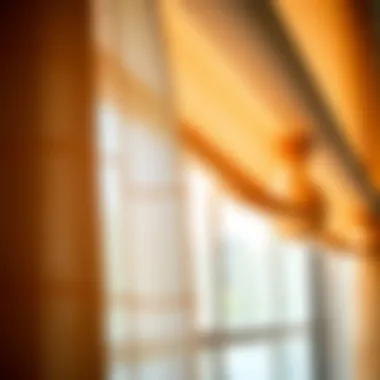

Fading Resistance
Fading resistance refers to how well a fabric holds up against sunlight. Fabrics treated for UV resistance can maintain their color intensity longer under direct sunlight. This trait is especially beneficial in sun-drenched rooms, where less durable fabrics could fade dramatically. However, such treatments may come at a higher cost and not all fabrics come with built-in fading resistance.
Wear Over Time
Finally, wear over time is a crucial factor, as every fabric has a lifespan influenced by usage, exposure to light, and the environment. Natural fibers, while beautiful, can be prone to wear more quickly than synthetic options, particularly in high-traffic areas. Assessing how often you will use the window scarf can guide your choice significantly. If you want something that lasts and withstands loads of use, you might lean towards sturdy options like polyester blends. In contrast, if the scarf is more decorative with less daily interaction, natural fabrics can be a good fit despite the wear limitations.
By considering these various elements like fabric type, durability, and maintenance needs, you can make an informed choice that not only suits your style but also caters to your long-term function wants.
Always remember that selecting the right material for your window scarf isn't merely about aesthetics; it's about creating a functional piece that enhances your living space for years to come.
Tools Required for Installation
To hang a window scarf properly, having the right tools is crucial. The tools you select not only streamline the installation process but also impact the final look of your window treatment. Here’s why it’s important to equip yourself with specific hardware and installation aids, and how they can make the process more efficient and effective.
Necessary Hardware
Rod or Rail
A rod or rail serves as the backbone of any window scarf installation. This essential piece of hardware provides the structural support needed to hold the fabric in place, creating that beautifully draped appearance that can transform a room.
The key characteristic of a rod is its versatility. Whether you opt for a standard straight rod or a decorative, more specialized rail, each option adds its own flair to your window treatment. For example, a decorative rod can be a statement piece while fulfilling its basic function.
A notable feature of rods and rails is their ability to accommodate varying fabric weights. However, they do have limitations; not all rods will fit under standard brackets, meaning a little homework ahead of time may be necessary.
Hooks and Clips
Hooks and clips are pivotal in maintaining the aesthetic and practicality of your scarf placement. They keep the fabric securely fastened, preventing it from slipping or falling out of position. A strong, dependable clip ensures the scarf hangs exactly the way you envisioned.
These components are particularly beneficial because they allow for quick adjustments. Looking for a more relaxed look? Simply loosen the clip and adjust. On the flip side, the choice of hook or clip can dictate how formal or casual the drape appears, giving you creative control.
Nonetheless, not all hooks are created equal. Some might scratch delicate fabrics while others can be a pain to install. Thus, choosing the right clips and hooks based on your fabric type and installation needs becomes vital.
Fasteners
Fasteners, like screw eyes or adhesive strips, can be game-changers in your window scarf project. They provide additional support, especially when you're dealing with heavier fabrics that need extra stability.
One of the key advantages of fasteners is their low visibility. Unlike some clips that can stand out against your fabric, good fasteners will be discreet while doing their job. However, always consider the material of your window treatment. While adhesive strips might work wonders on some surfaces, they could leave residue or damage on others.
Installation Aids
Measuring Tape
A measuring tape is one of the most indispensable tools you’ll have in your arsenal. Accurate measurements are essential; after all, there's no room for error when you're hanging a beautiful scarf across your window.
The strength of a measuring tape lies in its flexibility and ease of use. It allows you to measure all dimensions, ensuring that your scarf drapes perfectly. One unique feature is the hook at the end, which aids in getting precise measurements from various surfaces.
Bear in mind that using a measuring tape might seem trivial, but neglecting this simple step can lead to frustrating miscalculations and an uneven installation.
Level
Using a level goes beyond ensuring that your scarf is physically straight. A well-aligned installation contributes to a polished look. After all, naughtiness in leveling can lead to a domino effect of visual imbalance.
The main selling point of a level is its capability to reflect precision. Many levels come with built-in measuring features, allowing for a multifaceted approach to your installation. However, be cautious – a poor quality level could lead to inaccurate readouts, resulting in an uneven scarf.
Screwdriver
A screwdriver is a must-have, especially when it comes to securing hardware. It’s the tool that pulls everything together, quite literally. The right screwdriver, particularly a magnetic or multi-head one, can save you a lot of time during installation.
One notable aspect of screwdrivers is their variety. Depending on the screws used with your rods, having both Phillips and flathead options at hand becomes essential. Conversely, using the wrong screwdriver can lead to stripped screws or damage to your fixtures, making it a crucial selection.
In summary, gathering the right tools and hardware lays a solid foundation for your window scarf installation. Each component plays a role, from the basic supporting hardware to the aids that ensure everything is put together flawlessly. Paying attention to these details not only enhances the process but significantly elevates the final result, showcasing your decorative choices to their fullest.
Measuring for Your Window Scarf
Measuring for your window scarf isn't just a mere task; it's a critical step that lays the groundwork for achieving the coveted aesthetic you seek in your living space. Without precise measurements, you might find yourself in a pickle, either with too much fabric bunched up or not enough to create the desired drape. The right measurements contribute not only to visual appeal but also to functionality, ensuring your scarf complements the window’s architecture in a seamless manner.
Window Dimensions
Width and Height Considerations
The width and height of your window serve as the foundation for an effective window scarf installation. This aspect is vital because it determines how the fabric interacts with both the window frame and the surrounding decor. When measuring the width, it’s crucial to account for an overhang on both sides. This creates the illusion of larger windows and adds a touch of elegance. For height, you should measure from the top of the window frame to where you want the fabric to finish—whether just above the sill or to the floor.
A common mistake here is not considering the overall proportions. A scarf that's too short may look like it got caught in a draft, while one that's excessively wide may overwhelm the space. Striking a balance is key, making this a popular choice for window treatment.
Allowing for Fabric Drop
Allowing for fabric drop is equally crucial, touching upon how your scarf falls or hangs. This consideration encompasses the idea of letting your chosen fabric gracefully touch the window sill, or it may extend toward the floor for a more dramatic and laid-back vibe. The goal here is to strike just the right chord between style and practicality.
Just imagine a light, flowing scarf trailing down nicely with a gentle curve—this is where the drop plays its part. Going too short can make everything look a bit awkward. Conversely, if the fabric drop is too long, it could end up being a nuisance to maintain. Balancing the drop adds sophistication yet demands careful attention during installation.
Spacing from Window Frame
Next up is spacing from the window frame. This measurement dictates how far your scarf drapes away from the window itself. Neglecting this can result in a scarf that looks cramped and uninspired. The preferred spacing generally allows for at least a few inches between the edge of the scarf and the frame, offering essential breathing room and accentuating the window's features.
This can also help in avoiding unwanted dust accumulation since the scarf won't be pressed directly against the window. However, adding too much space could lead to visual disarray, where the scarf seems disconnected from the window itself.
Determining Length and Width of the Scarf
Knowing how to determine the length and width of your scarf is essential for enhancing the overall window treatment aspect. This step breaks down into two crucial methods—calculating lengths and choosing widths that align with the desired style of your home.
Length Calculation Methods
Length calculation methods typically involve a straightforward approach. You’ll want to consider how far you want the fabric to fall and where you want the scarf to start. A popular method is to measure the total length and then add fabric for a relaxed loop or additional drape, allowing a more whimsical look or a tailored finish. The essence of this method is adaptability, melding your creativity into practical dimensions.
This method is favorable as it gives room for some variation, enabling you to adjust the length based on seasonal themes or even personal preference. But keep in mind that a poor calculation here can throw everything off balance.


Choosing Width Based on Style
Finally, choosing width based on style amplifies the effect your window scarf has on your room. Width typically ranges from a third to twice the width of the window, with an increase often creating a more voluminous look. Thinner scarves might work for modern or minimalist styles, while broader ones play well within more traditional or dramatic interiors.
Selecting the right width not only frames the window effectively but also enhances the overall atmosphere of the space, making this an essential part of your scarf hanging journey. However, too broad can appear cluttered, while too narrow may look lost in the scheme—perfection lies in the balance.
Techniques for Hanging Window Scarves
Hanging a window scarf is not just about draping a piece of fabric over a rod; it's an intricate dance of style and function. This section dives into practical techniques, offering insight on how to make the most of this decorative accent. Employing thoughtful methods can elevate any space, ensuring your window scarf not only looks stunning but also enhances the ambiance of the room. Understanding the correct techniques can make all the difference in achieving both aesthetic appeal and practicality.
Draping Techniques
Single Layer Drape
The single layer drape technique is about simplicity and elegance. This method uses one piece of fabric flowing down from the rod, creating a light and airy feel in the room. It often highlights the fabric's natural textures and colors, allowing its beauty to shine through. A key characteristic of this style is its ease of implementation. If your windows are small or your space requires a minimalist approach, this technique is a great fit.
One unique feature of the single layer drape is how it can effortlessly soften the hard lines of window frames. The advantages of this technique include quick installation and easy adjustment. However, one should be aware that it may lack some fullness, making it sometimes appear less luxurious compared to layered styles. While it looks great, it might end up feeling a touch sparse in larger spaces.
Double Layer Drape
Moving into a more opulent option, the double layer drape technique adds depth and dimension. This method uses two materials, one behind the other, which allows homeowners to combine different textures or colors. The key here is that it can dramatically enhance the visual interest of a window treatment. If you’re aiming for something that catches the eye, then this style is worth considering.
With a unique feature, the double layer style provides better light control while still allowing for fabric play. While it makes a strong decorative statement, its disadvantages include a slightly more labor-intensive setup and possibly more cost, depending on fabric choices. However, it certainly pays off by adding a richer look to your decor, making it a wise choice for those seeking sophistication.
Twisted or Knotted Styles
For those who want to branch out into creativity, twisted or knotted styles bring an unconventional flair that can add individuality to your decor. This technique involves twisting or tying the scarf into knots, creating playful shapes and arrangements. What stands out about this method is the ability to customize the look entirely; it showcases your unique style and can even be a conversation starter.
The beauty of this style lies in its versatility. You can easily adjust how casual or formal you want it to appear. One downside is that it can be less stable than other methods, especially if you're utilizing lighter fabrics. However, the quirky charm it brings makes it a compelling choice for those wanting to express their personality through home decor.
Securing the Scarf
Securing your window scarf properly is crucial. This section will discuss the various methods to keep your scarf in place while maintaining its aesthetic integrity.
Using Clips and Hooks
Employing clips and hooks is one of the most reliable methods to secure window scarves. Their sturdiness ensures that your scarf won't droop or slide down. This technique highlights the dependable nature of clips and hooks, as they can be easily attached to the rod without extensive modifications. Clips can be particularly beneficial for those who want the option to change out their scarves regularly, offering flexibility for seasonal decor changes.
However, a disadvantage might come from the visibility of the clips, depending on their design. People may find less aesthetic appeal in the hardware showing, which can detract from the scarf's elegance. Yet, for the practical homeowner, their functionality often outweighs this minor con.
Creative Tying Methods
This section gets the creative juices flowing. Utilizing unique tying methods can keep your window scarf secure while adding an chich touch to your decor. Whether it’s a simple bow or a more intricate knot, this method gives you the freedom to decide how playful or sophisticated you want the look to be.
A key characteristic of this approach is its flexibility. Tying methods can easily adapt to the type of fabric or the style of the room. However, the downside is that these methods may require a bit more skill and patience to master. Some might struggle with inconsistent results, but with practice, the creative tying could also add a personal touch that standard methods just can’t provide.
Weighting the Ends
Adding weight to the ends of a window scarf can be like putting the cherry on top of a sundae. This technique ensures that the scarf drapes beautifully while preventing it from blowing around in drafts. The extra weight can help create a more defined shape, adding to overall aesthetics by promoting an intentional, unfussy look.
A unique feature of weighing ends is how it helps the scarf stay in place, especially in spaces that experience wind. It presents the advantage of a more polished appearance that enhances the overall decor. On the flip side, one should be careful with material choice; adding too much weight could distort lighter fabrics. Nevertheless, when executed properly, this method ties together all the elements of a well-styled window.
Styling Ideas for Window Scarves
When it comes to enhancing the look of your windows, styling is key. This section delves into the creative potential that window scarves hold, providing you with practical ideas to refresh and elevate your home décor. Whether your goal is to add warmth to a space or to create a striking focal point, thoughtful styling can achieve that in no time. By understanding color coordination, pattern mixing, and seasonal themes, you'll not just dress your windows, but also tie your entire room together, creating a harmonious visual story.
Complementing Home écor
Color Coordination
Color coordination is fundamental in making a cohesive interior aesthetic. It's all about harmonizing the shades of your window scarf with the existing color palette of a room. Imagine a bold navy blue scarf against neutral walls; it adds depth without overwhelming the space. The primary characteristic of color coordination is its ability to either complement or contrast, depending on your design vision. For this guide, focusing on complementary colors helps promote a soothing environment that feels well thought out. One advantage of color coordination is that it allows different elements within a room to echo each other, creating unity. However, if colors clash, it could make the space feel chaotic, so careful thought is essential.
Pattern Mixing
Pattern mixing can breathe life into an otherwise dull space. It’s pairing two or more different patterns together in a way that is visually engaging but not overly busy. For instance, a floral scarf can work beautifully when layered with striped curtains. The key is to select patterns that share a common color scheme or motif. Pattern mixing, if done correctly, becomes a focal point in your decor, rather than a distraction. This technique adds a layer of interest and individuality, reflecting personal style. However, one must tread carefully—too many clashing patterns can create visual noise that detracts from the overall aesthetic.
Seasonal Themes
Embracing seasonal themes in your window scarves allows for a dynamic decorating approach. Each season brings with it distinct feelings and colors. For example, a light, airy scarf in pastel tones might fit beautifully with spring's fresh vibe, while warmer, richer fabrics may suit the coziness of autumn. This adaptability makes seasonal themes a popular choice; they keep your décor lively and in sync with nature’s transitions. One unique feature of seasonal styling is the opportunity to refresh your space without a complete overhaul—simply switching scarves can give your windows a whole new look and feel. While the downside is the need for storage during off-seasons, the benefits of a fresh look outweigh the hassle.
Layering with Other Treatments
Pairing with Curtains
Pairing window scarves with curtains creates a sophisticated layered look. This approach marries the functionality of curtains with the visual appeal of scarves, allowing for flexible light control and added privacy. The key characteristic here is the depth layering provides; it enhances both texture and style. This combination can be particularly beneficial in formal spaces, where the elegance of both treatments elevates the overall appearance. Combining fabrics does require a keen eye—choosing scarves that either match or harmonize with curtain colors is crucial to ensure a refined look, while contrasts can draw attention to the windows themselves.
Using Blinds or Shades
Integrating blinds or shades with window scarves can be practical as well as decorative. The versatility of blinds allows for controlling light effectively, while a scarf adds flair and softness. The primary strength of this layering technique lies in its practicality—it offers privacy while still providing aesthetic appeal. This combo is especially helpful in rooms where direct sunlight can be an issue. One should be mindful of the scarf's bulk compared to the slim profile of blinds; too much fabric can clutter the window and detract from the sleek lines of shades.
Accent with Valances
Valances are a classic treatment that pairs remarkably well with window scarves. By using a valance above your scarf, you introduce another layer of décor that can enhance style. The inspiring element of accenting with valances lies in their ability to draw the eye upward, creating a sense of height in the room. This can be particularly beneficial in smaller spaces where you want to create the illusion of volume. However, valances can sometimes feel overly traditional, so pairing them with contemporary scarves may strike the right balance between classic and modern.
In creative interior design, every detail counts. Styling your window scarves with intention can lead to environments that reflect your unique tastes and preferences.
By understanding these styling ideas for window scarves, homeowners and decorators alike can transform a simple decorative fabric into an integral part of their home’s aesthetic.
Common Mistakes to Avoid
Decorating with window scarves can bring personality and sophistication to your spaces, but making some common mistakes can lead to disappointment. Understanding these pitfalls is essential for achieving that polished look and ensuring your effort pays off. Here, we’ll highlight three key areas where many stumble and offer insights into how to sidestep these traps effectively.
Choosing Inappropriate Materials
Selecting the right fabric is like finding the perfect pair of shoes; they should harmonize with your needs and aesthetics. Opting for inappropriate materials can turn your grand design into an eyesore. For example, using a heavy fabric in a space that favors light, airy vibes can weigh down the entire decor. Similarly, sheer fabrics in a place needing warmth might leave the room lacking.
Consider the ambiance you wish to create. Cotton blends provide versatility; they are durable and easy to clean, making them suitable for everyday settings. Meanwhile, silk presents a touch of luxury, but they come with high maintenance. Opt for materials that align with your lifestyle and the function of the room. Choosing wisely here isn’t just about looks; it’s about blending usability with style.
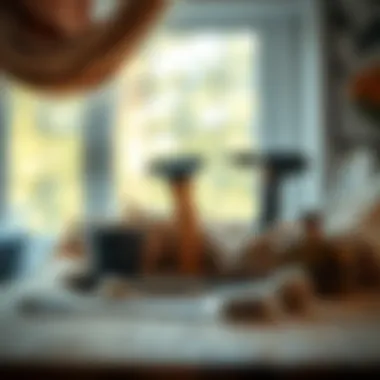
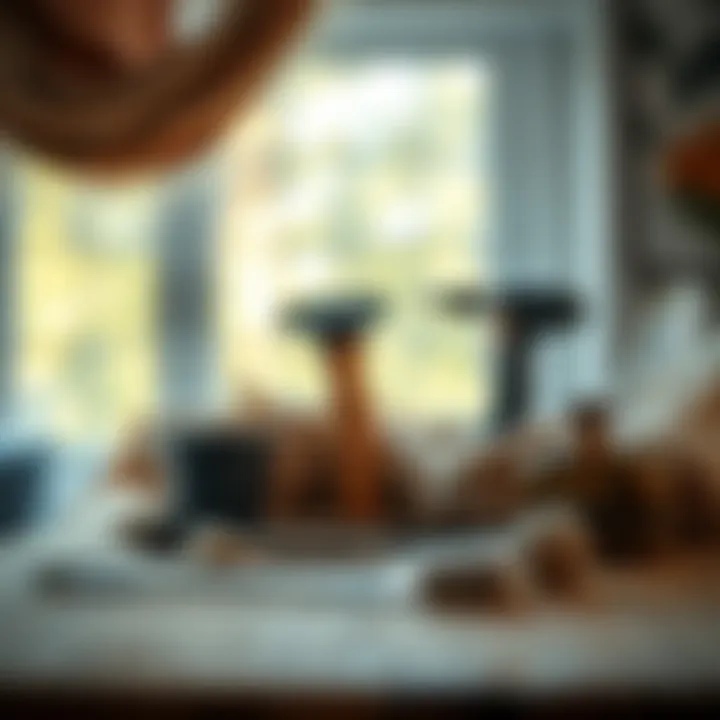
Miscalculating Measurements
Measurements may seem trivial, but they can make or break your window scarf experience. Imagine draping a scarf that’s far too short or absurdly long - it could lead to a less than flattering appearance. Not getting this right results not only in an aesthetically displeasing look but also in a significant waste of money and time.
When measuring, take your time. Use a measuring tape and jot down window dimensions meticulously. Don't forget: allowing for fabric drop is crucial too. It’s that simple extra inch or two that might prevent the scarf from looking like it was thrown on in haste. A good approach is to measure twice to ensure the length fits the intended drape you want to achieve.
Neglecting Maintenance Needs
Many homeowners fall into the trap of selecting beautiful scarves without considering maintenance requirements. It’s awfully easy to forget that upkeep can dictate how long your lovely scarves will last. Some fabrics may fade quickly when exposed to sunlight, while others can swallow dirt and stains like a sponge.
Rotate your scarves with the season if you can. This not only refreshes the look but also reduces wear and tear on any one specific piece. As a rule of thumb, always check the care labels before choosing materials. Make sure you’re up for the challenge rather than committing to a fabric that ends up being a weed in your garden of décor.
Attention to detail, particularly in the realm of fame, can ensure your window scarves remain a fabulous focal point.
Avoiding these mistakes can elevate your decor, enhancing your living environment and preserving the investment in decorative elements. Think carefully about fabrics, get measurements right, and stay on top of maintenance to keep your window scarves as a source of pride rather than regret.
Maintenance Tips for Window Scarves
Maintaining your window scarves is essential for preserving their beauty and functionality. Just like a well-tended garden, the right care can keep your window treatments looking fresh and vibrant, enhancing the overall aesthetic of your space. Here, we explore various aspects of maintaining window scarves, from cleaning to proper storage, ensuring they remain in top-notch condition.
Cleaning Methods
Hand Washing Techniques
When it comes to caring for delicate window scarves, hand washing often comes out on top. This method allows for greater control, preventing potential damage that can occur in harsher washing environments. Washing by hand is gentle, making it a popular choice for fabrics that might be prone to fraying or fading.
Some unique aspects of this technique include:
- Gentle Cleaning: You can choose the temperature of the water, ensuring that you don’t inadvertently shrink or distort the fabric.
- Detergent Control: It allows for selecting mild soaps that won’t affect color or integrity.
While this method is quite beneficial, it can be time-consuming. Still, many find the meticulous approach worth it, especially for high-quality fabrics. Remember, patience is key in this instance.
Machine Washing Guidelines
For those who prefer a more hands-off approach, machine washing can be a viable option as well. This method is efficient and suited for scarves made from durable materials. In many cases, modern machines come equipped with gentle cycles designed for delicate fabrics.
Notable characteristics of machine washing include:
- Convenience: It saves time and effort compared to hand washing.
- Consistent Results: With the right settings, you can achieve a thorough clean.
However, it’s vital to use mesh laundry bags and a cold wash to protect your scarves. One drawback, though, is the risk of items getting tangled or caught during the cycle, which could damage the fabric.
Spot Cleaning
Spot cleaning is a lifesaver for tackling small stains without subjecting the entire scarf to washing. This method is particularly advantageous for quick fixes, like crayon marks or food spills, allowing you to address issues as they arise.
The highlight of spot cleaning is:
- Immediate Attention: It targets specific problems without unnecessary washing, extending the scarf's lifespan.
- Selective: You apply a cleanser only where needed, often with no need to wash the whole fabric.
Although this technique is handy, it may not be sufficient for deep cleansing or when the fabric has collected dust over time.
Storage Recommendations
Storage is just as important as cleaning when it comes to maintaining window scarves. Proper techniques can prevent creasing and ensure they last for years to come. Here, we detail two primary methods: folding and hanging.
Folding vs. Hanging
Folding your window scarves is often the most space-efficient method, particularly for off-season storage. When folded neatly and placed in a drawer or box, scarves are protected from dust and dirt.
However, hanging is preferred for longer-term storage as it minimizes creases:
- Hanging: This allows the fabric to breathe and retain its shape, often preventing those pesky wrinkles that can come with folding.
- Folding: It saves space, but it’s crucial to check periodically for any signs of crease damage.
Ultimately, the method you choose can depend on the fabric and how frequently you plan to use the scarves.
Seasonal Switching
Seasonal switching is an opportunity to refresh your home’s look while keeping your scarves in good condition. For example:
- When spring rolls around, consider bright, airy fabrics that match the mood of the season.
- During winter, heavier, richer materials can add warmth to your decor.
The unique aspect here is that changing window scarves can create a sense of newness and relevance to the seasons, giving your home a fresh aura. However, it can lead to wear over time if switched out too frequently without care, so moderation is the best practice.
Final Thoughts
The importance of concluding an article on hanging window scarves cannot be overstated. This section doesn't just sum things up; it brings together everything discussed, allowing readers to reflect on the essential tips and techniques shared throughout the piece. Having a solid grasp of the topic's core ideas empowers homeowners, designers, and DIY enthusiasts to make informed choices as they elevate their interior design game.
One of the notable benefits of understanding these techniques is that it encourages better decision-making. Whether it’s selecting the right material or choosing the perfect draping style for a window scarf, informed choices can drastically change the appearance and feel of any room. It’s all about creating a space that reflects personal style while remaining functional—a fine balance worth striving for. In addition, a well-thought-out scarf treatment can mask less appealing window features, providing a stylish alternative.
Moreover, this section urges one to view window treatments, not merely as functional elements but also as artistic expressions. Incorporating creativity can truly enhance the ambiance of one’s home, transforming mere fabric into a statement piece. Paying attention to aesthetics while keeping practicality in mind is key.
The closing thoughts should also touch on the evolving trends in interior design, emphasizing the dynamic nature of style preferences. Window scarves can serve as a canvas for personal expression—it's about mixing tradition with the avant-garde in a way that resonates with the owner’s unique taste. To leave an impression, one should think creatively and perhaps dare to be different.
"In the end, your home is a reflection of you. Let your style shine through every detail, from the smallest accents to the grandest designs."
In wrapping up, navigating the world of window scarves might seem daunting at first, but through the tips and techniques provided, it’s clear that it’s a delightful journey of creativity waiting to unfold. Embrace the challenge, experiment with styles, and let each scarf tell a story within your home.
Recap of Key Points
As we draw this discussion to a close, it’s worthwhile to revisit the key elements of hanging a window scarf. A few points stand out that are fundamental to successful implementation:
- Material Matters: Choosing the right fabric is crucial. Consider factors like weight, drape, and washability to ensure the scarf meets your needs.
- Proper Measurements: Always take precise measurements of your windows and consider the desired drop and style of the scarf to avoid unnecessary complications later on.
- Installation Techniques: Knowing how to hang and secure the scarf effectively will not only enhance appearance but also ensure longevity.
- Creative Expression: Above all, window scarves invite creativity. Mixing colors, patterns, and textures can make a dramatic impact on your decor.
Encouragement for Creative Expression
When it comes to window scarves, the design choices are endless. Each scarf presents an opportunity to showcase personal style, and this is where true creative expression can shine through. Don't be afraid to explore different possibilities—this is where fun meets function.
Think outside the box. For instance, scout flea markets for vintage fabrics or consider layering distinct patterns for a fresh twist. A bit of experimentation can yield remarkable results. Pairing a bold color scheme with subtle hues can create a beautiful contrast that captures the eye.
Moreover, seasonal adaptations can be a thrilling aspect of using scarf treatments. Imagine a light, sheer scarf for spring and summer that can be easily switched out for richer, heavier fabrics in the fall and winter. This approach not only keeps the decor feeling current but also engages creativity by choosing new themes throughout the year.
Consider also showcasing unique tying methods or employing unexpected hardware for hanging. Each of these small nuances adds personality and flair to the home.
In essence, the goal is to transform any space into a reflection of your tastes through window scarves. So, go ahead, be imaginative, and let your home speak volumes without saying a word.

